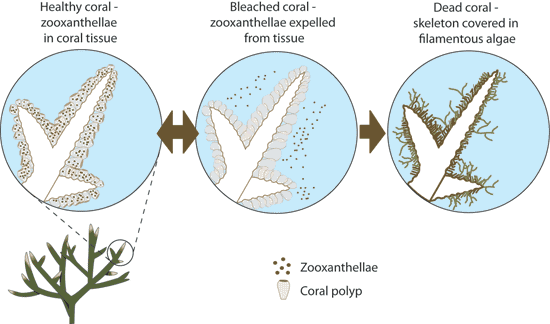What are Corals?
Coral colonies are made up of hundreds or even thousands of genetically identical individuals called polyps. These polyps have microscopic algae called zooxanthellae living within their tissues. The coral provides the zooxanthellae with the compounds necessary for photosynthesis, which are metabolic waste products of the coral. In return, the zooxanthellae produce oxygen and help the coral to remove wastes. Most importantly, they supply the coral with organic products of photosynthesis which are predominantly carbohydrates. These compounds are utilized by the coral as building blocks in the manufacture of fats, as well as the synthesis of their calcium carbonate skeletons. Each coral polyp builds a skeleton of calcium carbonate. These corals together form a coral reef.
How does a coral get its brilliant collour? A byproduct of the symbiotic relationship with zooxanthellae is color. Several million zooxanthellae live and produce pigments in just one square inch of coral. These pigments are visible through the clear body of the polyp and are what gives many reef-building coral their beautiful color. When the symbiotic relation between zooxanthellae and coral breaks, it turns white. This is coral bleaching.
What is Coral Bleaching ?
When corals face stress by changes in conditions such as temperature, light, or nutrients, they expel the symbiotic algae zooxanthellae living in their tissues, causing them to turn completely white. This phenonmen is called coral bleaching. The pale white colour is of the translucent tissues of calcium carbonate which are visible due to the loss of pigment producing zooxanthellae.
Coral bleaching has occurred in the Caribbean, Indian, and Pacific oceans on a regular basis. Many different hypotheses exist as to the cause behind coral bleaching.
How is it caused ?
1. Elevated sea temperature – This is considered to be the most common factor responsible for extensive coral bleaching. Corals grow in warm shallow waters that receive plenty of light. A few species can tolerate cooler and deeper waters. However, most coral species live in waters close to the warmest temperature they can tolerate- 29° C. This means that slight increases in ocean temperature can harm corals.
El Nino elevates the sea temperature and destroys coral reefs. The last big El Niño in 1998 caused the worst coral bleaching in recorded history. It destroyed about 15% of the world’s corals.
2. Ocean Acidification – There is a rise in carbon dioxide levels. Oceans absorb the carbon dioxide. When the uptake increases, the acidity of ocean water increases. This inhibits the corals ability to create calcareous skeletons, which is essential for their survival.
3. Solar radiation and ultraviolet radiation – UV radiation induces coral bleaching. Global warming causes changes in tropical weather patterns which results in less cloud cover and thus more radiation. In fact, reduced cloud cover also affect solar radiation.
4. Infectious Diseases causes by bacteria vibrio shiloi inhibits photosynthesis of zooxanthellae. These bacteria become more virulent with elevated sea temperatures.
5. Chemical pollution and increased elemental nutrient concentrations increase the density of zooxanthellae . Thereby lowering coral resistance to diseases.
5. Increased sedimentation due to poor land use, deforestation, dredging make the algae more prone to bleaching.
6. Human induced threats like over fishing, especially using damaging practices like cyanide fishing , pollution from agricultural and industrial runoff, coral mining, development of industrial areas near coral ecosystems are also causes. Remember, Adani’s coal plant in Australia made news – it is a threat to the corals.
What are the consequences ?
Coral reefs cover an area of over 280,000 km2 and support thousands of species, thus described as the “rainforests of the seas”. Coral reefs benefit the environment and people in numerous ways.
The death of corals and the resulting disappearance of reefs would result in the loss of a number of marine animals that rely on the reef for survival. The entire food chain gets disturbed then. The elimination of coral reefs would also result in great losses of income and resources from tourism. Corals also hold prospects as medicinal value for humans. Its a potential loss there. Coral reefs also protect coastlines by absorbing constant wave energy from the ocean, thereby protecting people living near the coast from increased storm damage, erosion and flooding.
Learn snorkeling and take a dive before the corals disappear !





Leave a Reply